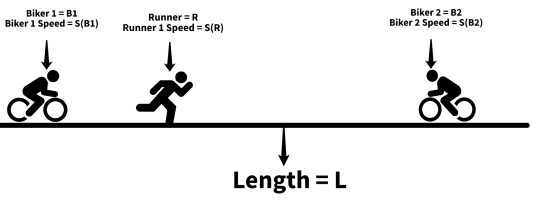Hello,
What is the probability that, given a 24-hour period, a runner, R with speed S(R), and two bikers, B1 and B2 with speeds S(B1) and S(B2), pass each other on a line, L, assuming the runner and one biker will start at one end of the line and the other biker starts at the other end?

Here is my attempt and please help correct or shed light on how to think about this.
Short answer:
[math]\frac{L^4}{S(R)*S(B1)*S(B2)^2*24^4}=\frac{L}{S(R)*24}*\frac{L}{S(B2)*24}*\frac{L}{S(B1)*24}*\frac{L}{S(B2)*24}=P(R,B2) * P(B1,B2)[/math]
Meaning of the symbols:
L = Length of the line
S(R/B1/B2) = Speed of R/B1/B2, in same distance units as length of the line over hours
P(R,B2) = Probability that R meets B2
P(B1,B2) = Probability that B1 meets B2
Long answer with explanation:
I think the answer is found by multiplying the probability of two independent events:
(Probability that R and B2 meet) * (Probability that B1 and B2 meet)
Which should be the same as the following, but going to focus on the above for simplicity.
(Probability that R and B1 meet) * (Probability that B1 and B2 meet)
To break that down,
(Probability that R and B1 meet) = ( (The time it takes for R to run the path) / (Period of time) ) * ( The time it takes for B2 to bike the path) / (Period of time) )
(Probability that B1 and B2 meet) = ( (The time it takes for B1 to bike the path) / (Period of time) ) * ( The time it takes for B2 to bike the path) / (Period of time) )
(The time it takes for R/B1/B2 to complete the path) = (Length of the path) / ( R/B1/B2's speed)
For example,
L = 1000 meters
S(R) = 3600 meters / hour = 1 meter / second
S(B1) = 7200 meters / hour = 2 meters / second
S(B2) = 7200 meters / hour = 2 meters / second
[math]P(R,B1)=\frac{\frac{1000 m}{3600\frac{m}{h}}}{24h}*\frac{\frac{1000 m}{7200\frac{m}{h}}}{24}=\frac{1000 m}{3600\frac{m}{h}*24h}*\frac{1000 m}{7200\frac{m}{h}*24h}=\frac{(1000 m)^2}{2*(3600\frac{m}{h})^2*(24h)^2}=\frac{25}{373248}=0.00006697959=6.69795953 × 10-5[/math]
[math]P(B1,B2)=\frac{\frac{1000 m}{7200\frac{m}{h}}}{24h}*\frac{\frac{1000 m}{7200\frac{m}{h}}}{24}=\frac{1000 m}{7200\frac{m}{h}*24h}*\frac{1000 m}{7200\frac{m}{h}*24h}=\frac{(1000 m)^2}{(7200\frac{m}{h})^2*(24h)^2}=\frac{25}{746496}=0.00003348979=3.348979 × 10-5[/math]
The answer for the example would be P(R,B1) * P(B1,B2) so
[math]\frac{25}{746496}*\frac{25}{373248}=\frac{625}{278628139008}=2.2431331096e-9[/math]As a percentage %2.2431331e-7 which seems minuscule.
Mental aids
While trying to simplify this problem in my mind, I thought to replace each independent event with a flip of a coin. Ignoring the exact probability for a minute, replacing the runner meeting one biker with one flip of the coin helped because it showed that, in a sense, they're just independent events. Also, the other biker meeting them would be just like another coin flip landing tails just as the first coin tip landed tails. Sometimes, the one event affects the other, but that doesn't seem to be the case here.
Thanks.
Credits:
Icons by Flaticon.com
What is the probability that, given a 24-hour period, a runner, R with speed S(R), and two bikers, B1 and B2 with speeds S(B1) and S(B2), pass each other on a line, L, assuming the runner and one biker will start at one end of the line and the other biker starts at the other end?

Here is my attempt and please help correct or shed light on how to think about this.
Short answer:
[math]\frac{L^4}{S(R)*S(B1)*S(B2)^2*24^4}=\frac{L}{S(R)*24}*\frac{L}{S(B2)*24}*\frac{L}{S(B1)*24}*\frac{L}{S(B2)*24}=P(R,B2) * P(B1,B2)[/math]
Meaning of the symbols:
L = Length of the line
S(R/B1/B2) = Speed of R/B1/B2, in same distance units as length of the line over hours
P(R,B2) = Probability that R meets B2
P(B1,B2) = Probability that B1 meets B2
Long answer with explanation:
I think the answer is found by multiplying the probability of two independent events:
(Probability that R and B2 meet) * (Probability that B1 and B2 meet)
Which should be the same as the following, but going to focus on the above for simplicity.
(Probability that R and B1 meet) * (Probability that B1 and B2 meet)
To break that down,
(Probability that R and B1 meet) = ( (The time it takes for R to run the path) / (Period of time) ) * ( The time it takes for B2 to bike the path) / (Period of time) )
(Probability that B1 and B2 meet) = ( (The time it takes for B1 to bike the path) / (Period of time) ) * ( The time it takes for B2 to bike the path) / (Period of time) )
(The time it takes for R/B1/B2 to complete the path) = (Length of the path) / ( R/B1/B2's speed)
For example,
L = 1000 meters
S(R) = 3600 meters / hour = 1 meter / second
S(B1) = 7200 meters / hour = 2 meters / second
S(B2) = 7200 meters / hour = 2 meters / second
[math]P(R,B1)=\frac{\frac{1000 m}{3600\frac{m}{h}}}{24h}*\frac{\frac{1000 m}{7200\frac{m}{h}}}{24}=\frac{1000 m}{3600\frac{m}{h}*24h}*\frac{1000 m}{7200\frac{m}{h}*24h}=\frac{(1000 m)^2}{2*(3600\frac{m}{h})^2*(24h)^2}=\frac{25}{373248}=0.00006697959=6.69795953 × 10-5[/math]
[math]P(B1,B2)=\frac{\frac{1000 m}{7200\frac{m}{h}}}{24h}*\frac{\frac{1000 m}{7200\frac{m}{h}}}{24}=\frac{1000 m}{7200\frac{m}{h}*24h}*\frac{1000 m}{7200\frac{m}{h}*24h}=\frac{(1000 m)^2}{(7200\frac{m}{h})^2*(24h)^2}=\frac{25}{746496}=0.00003348979=3.348979 × 10-5[/math]
The answer for the example would be P(R,B1) * P(B1,B2) so
[math]\frac{25}{746496}*\frac{25}{373248}=\frac{625}{278628139008}=2.2431331096e-9[/math]As a percentage %2.2431331e-7 which seems minuscule.
Mental aids
While trying to simplify this problem in my mind, I thought to replace each independent event with a flip of a coin. Ignoring the exact probability for a minute, replacing the runner meeting one biker with one flip of the coin helped because it showed that, in a sense, they're just independent events. Also, the other biker meeting them would be just like another coin flip landing tails just as the first coin tip landed tails. Sometimes, the one event affects the other, but that doesn't seem to be the case here.
Thanks.
Credits:
Icons by Flaticon.com
Last edited:
